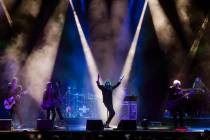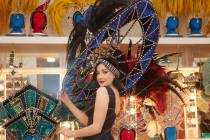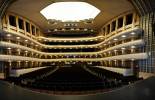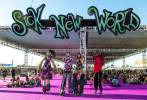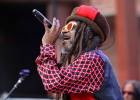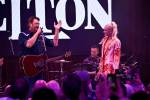Financing involved near 50-50 split of public, private money
To perform a symphony, an orchestra conductor leads musicians who, working in harmony, play a series of notes. If it's done right, the result is a beautiful melody that turns each individual note into a larger whole.
Now that The Smith Center for the Performing Arts has opened its doors, it marks the metaphorical world premiere of a symphony written to incorporate funds both public and private, working in concert in a way even a master composer would appreciate.
The $470 million Smith Center symphony began in the mid-'90s when a group of community leaders gathered to discuss "building a world-class performing arts center," said Donald Snyder, The Smith Center's board chairman.
After that meeting, he said, "a smaller group of us got together and formed the initial nonprofit corporation and board of directors to organize our efforts."
By 2000, the corporation had developed a business plan to identify exactly what had to be done and how it would be accomplished. From the beginning, Snyder remembered, "we said it has to be a public-private partnership."
Building the proposed center with a mix -- ideally, a 50-50 mix -- of public and private funding is "probably necessary" for such a project in any community, Snyder said, "but in Las Vegas, there's probably more necessity than most because we're a real young community. We don't have as much of a philanthropic infrastructure as a lot of communities, and we haven't had a cultural foundation as broad as more established communities."
For a performing arts center "to be taken seriously and for it to be done at the level we wanted to do it -- a world-class facility -- it really couldn't have been done on the back of just the public sector and shouldn't have been done on just the back of the private sector."
PUBLIC PARTICIPATION
Early in the process, organizers received a commitment from the city of Las Vegas to provide a downtown site for a proposed center.
"We said, if this is going to be a public-private partnership, we needed to get the public sector engaged first," Snyder noted. "So getting that commitment from the city to provide a site was part of that."
The next notes in the piece came in securing other possible public funding sources.
"We originally thought of some form of sales tax increment or room tax increment or something like that," Snyder recalled.
Ultimately, in 2005, a car rental fee was enacted that provided for a bond issuance that raised $101 million, said Richard Johnson, The Smith Center's vice president and chief financial officer. Also, the center received about $19 million in proceeds from the rental car fee before the bonds were sold.
By this time, the city of Las Vegas, following up on its earlier commitment, had designated a 61-acre site at Bonneville Avenue and Grand Central Parkway for the project. The value of that land plus the costs of environmental cleanup and other site improvements paid for by the city totaled about
$50 million. The city also contributed $69 million in redevelopment money, Johnson said, bringing the total public contribution to the project to about
$239 million.
PRIVATE FOUNDERS
Organizers also sought out private funding for the center. First, a program was created to honor donors of $1 million or more as Smith Center "founders."
"There is no way you can ask other people for a million-dollar donation if you're not prepared to sign up yourself," Snyder said. "That's when my wife and I agreed to be the first million-dollar donors to start the founders club."
Organizers figured they needed at least 50 founders who would donate at least $1 million each. In all, 57 founders came through, and founders and other donors to the center's capital campaign contributed about $81 million to the center, Johnson said.
The next significant step in raising private funding came in December 2004. It was then, Snyder said, that he had his first conversation with Fred W. Smith at the Reynolds Foundation.
Smith is a former executive of Donrey Media Group, former owner of the Las Vegas Review-Journal and many other papers across the country. He now serves as chairman of the Donald W. Reynolds Foundation, a philanthropic organization named after Donrey's founder.
During his first meeting with Smith and Steven Anderson, the foundation's president, Snyder briefed the men on the project's progress. When he was finished, Smith, according to Snyder, said he was impressed, but that the performing arts center probably was not something the board would be interested in.
Anderson said that since Reynolds' death in 1993, the foundation's strategy had been to focus on such concerns as education, aging and quality of life, and cardiovascular research.
"The feeling was that this was outside of the parameters of those strategic programs," Anderson said.
CHANGE OF HEART
However, Snyder said Smith also directed Anderson to brief the Reynolds Foundation board about the performing arts initiative, and Anderson said the board was encouraged then that there was a possibility of a public-private partnership.
"(Snyder's proposal) kind of opened our eyes," Smith said. "If you think of Las Vegas, it's the entertainment capital of the world, but it's not the cultural capital of the world."
Creating a world-class performing arts center here would, Smith said, meet a real need for culture in Southern Nevada.
In March 2005, the Reynolds Foundation gave the center a $50 million grant. Smith and his wife matched Snyder's own donation and became Smith Center founders (as did, through its donation, the foundation itself).
Anderson said about $5 million of that $50 million grant went to early planning and design costs. The rest was set aside as a permanent endowment "that would be used to operate the facility and run the programs after the project was completed and open," he said. "We were very interested in making sure that there were financial resources available to operate the facility after it was open."
Organizers' plans at that point called for completing the center's construction in phases.
"We got a little concerned about that," Anderson said. "We were afraid the main hall, Reynolds Hall, would be built and the rest of the planned buildings would not be built."
So, the Reynolds Foundation gave the project a second grant, this one for $100 million, that enabled completion of the entire campus and permitted the center to open, completely built, all at once.
Finally, it was decided that the new performing arts center would be named in honor of Fred W. Smith and his wife, Mary B. Smith. Smith wasn't involved in that particular decision, but was "stunned" when he learned of it.
"I was awestruck, I guess the term would be," Smith said. "I was very humbled by the board doing that."
Smith said he feels proud to be the facility's namesake. And, he added, "my wife, of course, passed away a couple of years ago, and she'd be very proud. I'm sorry she can't be here for the opening, but she's certainly looking down on it."
BUILT TO LAST
In the end, the capital campaign for the Smith Center totaled about $470 million. The final tally, Johnson said, was about $231 million in private funding and about $239 million in public funding.
That, Snyder noted, is "very close" to the 50-50 partnership hoped for at the outset.
The Smith Center calls the Reynolds Foundation's donation to the performing arts center the largest philanthropic donation in Nevada's history. And, thanks to the endowment money that already has been put aside, the center will open its doors with a measure of financial security.
"There's no performing arts center in the country that opened with as significant an operating endowment," Snyder said. "Most of them struggle to get the brick and mortar done and over the next few generations they try to build up an operating endowment."
"This is a wonderful, fully conceived, well-executed project," Snyder said. "In my mind, it's a textbook example of how the public and private sectors can come together and create something that is very, very positive."
Of course, fundraising will continue. Terry Jones, The Smith Center's vice president of development, said ticket sales typically make up about 80 percent of a performing arts center's annual budget, with the rest coming from a combination of rentals, food and beverage proceeds, corporate sponsorships and, then, annual fundraising from individuals.
But having an endowment in place "really demonstrates our strength in the community, so that people who are in here know we're going to be around for decades and decades," Jones said.
"From a fundraising perspective, I can tell prospective donors that there is a business plan in place and that we've got these elements in place that we're working toward, so people come away from making a gift feeling confident that their money is to be used wisely."
Or, to put it another way, Smith said, "I think they're on a sound foundation."
He smiles. "Play on words."
Contact reporter John Przybys at
jprzybys@reviewjournal.com or 702-383-0280.




















